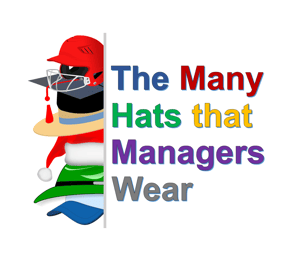The Problems with the Manager as Meeting Facilitator
 Multi-tasking, being efficient, and trying to get it all done is confusing for many managers. They take on roles that ought to be done by others, and they attempt to wear multiple hats at the same time. Managers of teams, for example, often take on the additional role of meeting facilitator.
Multi-tasking, being efficient, and trying to get it all done is confusing for many managers. They take on roles that ought to be done by others, and they attempt to wear multiple hats at the same time. Managers of teams, for example, often take on the additional role of meeting facilitator.
The two roles are inherently at odds with each other. A manager’s opinion and input carry so much weight that others defer or decline to participate once the manager’s leanings are known. A neutral facilitator has no sway and can extract more ideas and balance input, so more ideas are generated and discussed.
Rather than defaulting to manager as meeting facilitator, consider the differences between the two roles, outlined below. There may be times when this hat isn’t a good one for the manager to wear.
The Role of a Meeting Facilitator
To facilitate means to make something easier, to help forward, to ease progress. Facilitators lead or moderate discussions, meetings, training workshops, and events. Synonyms for facilitate include aid, ease, expedite, further, simplify, speed up, grease the wheels, and smooth.
Meeting facilitators guide a meeting. They make it easier to get through the agenda and expedite progress on discussions and decisions (without hampering quality). They foster discovery, draw all voices in, handle tangents or issues that could impede progress, and ask questions to promote alternate ways of looking at a situation.
Facilitators also use techniques that will help participants remember, refer back to, and synthesize ideas that have been offered. Techniques include whiteboarding, breakout groups, activities, brainstorming, reflection, and the like.
The job of a meeting facilitator is to conduct a meeting in a way that delivers on the predetermined objective(s) of the meeting in the time allotted. To achieve this, facilitators plan ahead and use facilitation competencies that fit the needs of the group.
Facilitation competencies include:
-
Asking quality questions
-
Actively listening
-
Ensuring that all viewpoints are heard and considered
-
Understanding how adults learn and process information
-
Recognizing conflict and building bridges between opposing views
-
Creating a “safe space” to encourage open, honest dialogue
-
Communicating to summarize, synthesize, and redirect
-
Capturing, objectively, key points and action items
-
Handling technology related to the meeting
-
Staying “in the moment” to hear, respond to, and act on new information
To facilitate effectively, especially when all angles of a situation need to be evaluated, it’s best if the facilitator is a truly neutral party. Maintaining objectivity makes it easier to fairly represent all sides of an issue and all voices in the meeting.
Unlike managers, facilitators have no preconceived notions about team members. They don’t interact with each individual the way a manager would, and they don’t have performance-informed “halos or horns” attached to anyone. Facilitators won’t make assumptions about hidden agendas, personality styles, intra-team conflict, or other dynamics that do influence managers.
The Role of a Manager in a Meeting
The role of the manager depends on the type and purpose of the meeting. For example:
Weekly Team Meetings are typically led by the manager of the team. That generally makes sense, since the manager has information to cascade, policies and announcements to review, connections between team members and projects to make, and a broader view of what the team needs to know. If the primary purpose of these meetings is to disseminate information, the manager is the one who is best suited to do this.
Daily Stand-Up Meetings don’t need a facilitator at all. If the meeting is routine, with each team member providing quick updates, have the manager’s updates be just like all the others, round robin.
Ad Hoc Meetings to discuss problems, changes, planning, and sub-group need a facilitator who is not directly involved in the decision-making and examination of all possibilities. The manager is probably too close to the action to be objective. There’s risk of poor decision quality when managers facilitate because some won’t speak up, especially once the manager’s opinion. In groups that strongly value harmony or are authority-driven, groupthink is likely to creep in.
Project Meetings for task force teams or sub-teams provide a perfect opportunity for all members to build facilitation skills. Rotating the role is helpful for participants and ensures that the manager doesn’t inadvertently oversteer the group’s thinking, decision-making, action-planning, or dialogue.
1:1 Meetings should NOT be facilitated by the manager. Rather than treating these as mini performance reviews, the focus should be on employee development. When employees are granted this time to discuss their progress and next steps for continual development, they can lead the meetings Managers can provide 3-5 questions that will guide the discussion. Asking employees to prepare to answer those questions and then giving them an opportunity to lead advances their development and builds confidence.
Teambuilding Meetings should involve every member of the team as a full participant, including the manager. After all, the manager is part of the team. If a manager facilitates and participates, it eliminates all activities that have known answers or strategies (since the manager will already have that information and, therefore, have an advantage over others). If discussion bubbles up, the manager who planned the event will not entertain it as openly as an objective facilitator would. There’s also less chance for the manager to relax and have fun alongside others if needing to focus on facilitation
Strategic Planning Meetings require a neutral facilitator. Every member of the team needs to be fully focused on the environmental scan, SWOT analysis, projections, ideation, and discussion related to big picture and long-term planning. Since these meetings also involve advocacy for one’s own ideas or represented function, a manager who participates and facilitates will not be able to be objective. In most cases, this individual’s own needs and representation are subdued in an attempt to facilitate without favoritism.
Ideally, managers facilitate when they know the information being shared and there will not be much discussion needed. They don’t facilitate when there is new information to surface and discuss, when fair representation of all ideas is needed, and when big decisions will be made by the team.
When the Manager Must Also Wear the Meeting Facilitator Hat
If it’s impossible to find a neutral facilitator from inside or outside the organization, the best course is for a manager to take these steps. These will reduce the likelihood of taking over instead of facilitating.
1. Write down your ideas and tuck them away, to be revealed only after all others have weighed in.
2. Describe the matter that will be discussed with complete neutrality. Include:
-
Synopsis of the situation
-
Purpose of the meeting (discussion, decision making, brainstorming?)
-
Expectations for all the participate
-
Clarification about manager’s role in the meeting (to be a neutral facilitator)
3. Throughout the meeting, refrain from facial expressions, body language, or words that would suggest approval or disapproval.
4. Use “facilitator speak” like “Tell me more…” and “What do others think of that?”
5. Conduct round robins, breakouts, reflection time, and activities that will draw all voices into the conversation. Allow time for those who prefer quiet processing time before speaking aloud.
6. Consider that your mind might be changed. Remain open and receptive to new ideas.
7. If others ask your opinion, decline to give it until the end.
Once the group has moved toward a unified solution or has produced several good ideas, introduce your own. Don’t advocate for it, don’t put pressure on the group to adopt your idea, and don’t compare it to other options. Instead, offer it up for discussion and go back into facilitator mode, mining for reactions and getting the team to respond to your idea just as they did to others’ ideas.
At the end of the meeting, once the stated purpose has been accomplished, don’t forget to recap action items (including your own).
After the meeting, survey the team to see how well you did in staying neutral and determining what you can do to improve for the next meeting.

.png)